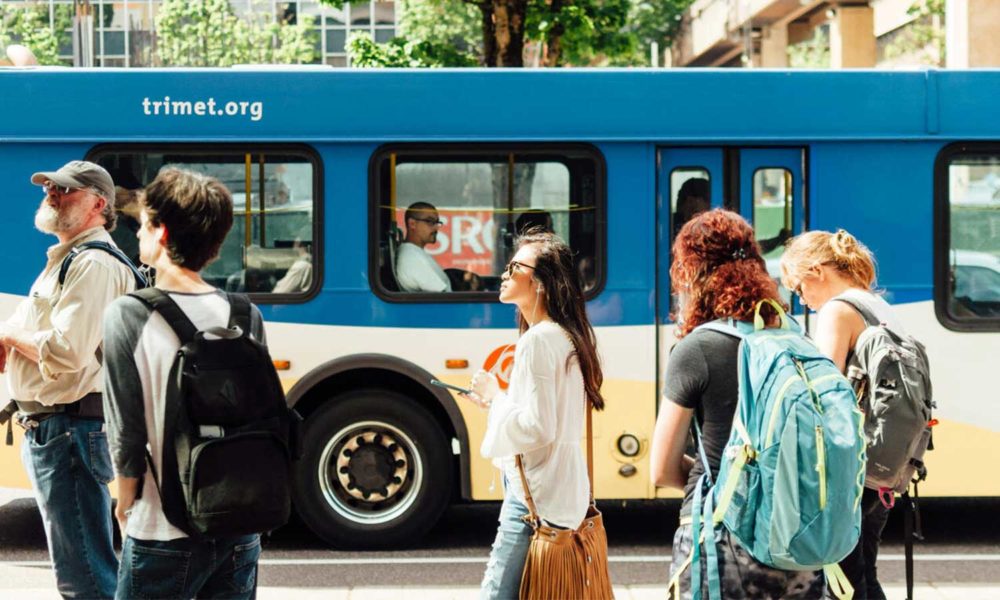We’ve heard it a lot. Riding transit is good for the climate. And the climate needs our help now more than ever. Is this true? Yes. Can we really make a difference by changing our transportation system? Also yes. Here’s how.
Transit lowers emissions, brings convenience
Transportation is about getting where we need to go—to where we live, where we play, where we work, where we pray. I have the hope that we can do this in a way that allows future generations to do the same. Riding a mile by bus in this country, on average, contributes 30% less to climate change than riding in a gas car alone. This accounts for average occupancy and holds true for most of the major transit systems in the country. Riding by rail is even better. Riding a bike or walking lowers your emissions down to zero. Each trip we make outside of a car makes a small difference in reducing your carbon footprint.
That’s where the story usually stops, but these replaced car trips are just a small piece of transit’s climate benefits. Transit investments push our communities to be more accessible no matter how you travel by encouraging more efficient clustered development. So even if you never ride a bus, transit investments help you go places while driving less, grouping trips together, or making it easier to walk or bike. This concept applies at all densities from big cities to rural areas—communities everywhere can benefit from transportation policy that makes it easier to get around.
The impact of these changes to our communities can reduce vehicle travel by anywhere from 5-12 times as much as the benefits from directly replaced car trips. Clustered development allows us to get to where we need to go without literally spinning our wheels an extra distance due to sprawling land use planning. The Intergovernmental Panel on Climate Change’s most recent comprehensive mitigation report similarly shows that compact and resource-efficient development patterns are a key portion of an overall transportation decarbonization strategy.
We need better transit not only for the climate though, but also because it enhances mobility for everyone in a country where driving is often the only option. Over 10 million US households in the United States do not have a car, whether that be due to high costs of ownership, maintenance, and insurance; inability to drive due to aging or disability; criminalization of poor drivers and inequitable traffic enforcement; or a range of other factors. Public transit can provide another way of getting around that is more accessible to all and reduces transportation emissions.
Are we there yet?
Transportation has been the biggest contributor to climate change in the US since 2016, and its emissions are only projected to increase in the future without significant changes. While fuel economy and efficiency standards, and current EV adoption push vehicles to emit less per mile, the growth in vehicles miles traveled (VMT) currently outpaces those increases. Improving the cars and trucks we drive has been crucial in reining in transportation emissions, and we will not make the magnitude of progress necessary on climate without just plain driving less.

The country had a dip in transportation emissions around 2005 after Hurricane Katrina, when damage to refineries and production caused oil prices to spike above $70 a barrel (that’s a lot). This was largely linked to a decrease in travel was amplified during the Great Recession, when lower incomes and a host of demographic factors made it seem like the US reached “peak driving”. On the contrary, within the decade, travel bounced back and kept climbing.
Through the first year of the COVID-19 pandemic, VMT decreased sharply. The world turned upside down, and people traveled less for both work and non-work activities. I was lucky enough to hole up in the virtual universe and rarely get into a vehicle most of that year. Those who weren’t so lucky often had to navigate a world of decreased transit service to carry out essential jobs and services. Though transportation emissions decreased around 10% from the previous pre-pandemic year, no one would wish for the turmoil and economic disruption that came with it. Since April 2021, travel has returned to pre-pandemic levels and has kept increasing, though with a different flavor—increasing truck traffic, less commute trips but more non-work trips, and unfortunate declines in transit ridership. Now that traffic is back, the benefits of providing frequent and reliable transit service are even more clear.

Now’s the time to advocate for transportation change
Here are some policies that can help push the needle:
Assess climate impacts when deciding on all transportation projects: Currently, highway and transit projects can get built without considering the carbon emissions increases or reductions they would bring. In December 2021, Colorado approved a greenhouse gas emission reduction standard to require this analysis, and other states are thinking to do the same. Reinstating a federal greenhouse gas performance measure in transportation planning could also require states to measure and reduce transportation emissions.
Increase transit investments and funding, especially electric ones: Transit has much room to improve. The latest federal infrastructure bill has given the opportunity for some major investments, though much more needs to be done. Transit operations funding (e.g. paying bus drivers) needs to be secured and increased for frequency and reliability of service. These investments will be even better for the climate if they are electrified, and many transit agencies and states across the country are setting targets for full transit electrification in the next two decades.
Set transit up for success with sustainable land-use policy: Federal, state, and local governments can enable walkable and compact communities as a foundation for transit investments. Investments in biking and pedestrian infrastructure can make these neighborhoods safer and more sustainable. Investing in affordable housing and anti-displacement measures can help in a world where a scarcity of transit-oriented development often pushes people out of their communities.
At UCS, we have advocated for electrifying transportation and more cleaner fuels for years. These are indeed important, and it’s clear that transit and land-use policies are part of the solution as well. Systemic change in making our transportation system connect people and things better is necessary if we want to effectively address the climate crisis, and this will take using all of the tools in our toolbox. There is no “easy fix” or “silver bullet” here, just lots of work to do!

